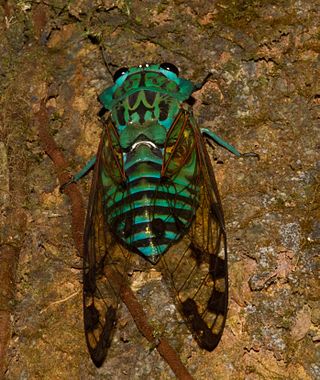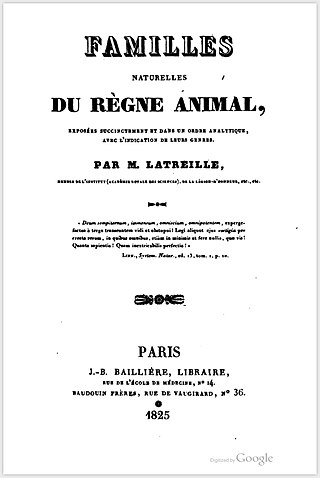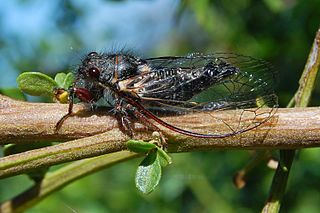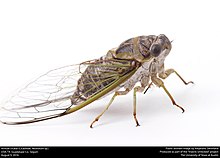
The Cicadinae are a subfamily of cicadas, containing the translucent cicadas. They are robust cicadas and many have gaudy colors, but they generally lack the butterfly-like opaque wing markings found in many species of the related Tibiceninae.

Gaeanini is a tribe of cicadas in the family Cicadidae, found in the Palearctic and Indomalaya. There are about 10 genera and at least 50 described species in Gaeanini.

Tosenini is a tribe of cicadas in the family Cicadidae. There are at least 10 described species in Tosenini, found in the Palearctic and Indomalaya.

Cryptotympanini is a tribe of cicadas in the family Cicadidae. They are found in the Nearctic, Palearctic, Indomalaya, Oceania, and Afrotropics.

The Fidicinini are a tribe of cicadas. There are at least 20 genera and 250 described species in Fidicinini, found in the Nearctic and Palearctic.

The Zammarini is a tribe of cicadas. They are native to the Americas, especially the Neotropics.

The Platypleurini are a tribe of cicadas from the Afrotropical and Oriental regions There are at least 30 genera and 240 described species in Platypleurini.

The Dundubiini are a tribe of cicadas in the family Cicadidae, found in the Palearctic, Indomalaya, Australasia, and the Western Pacific. There are at least 180 described species in Dundubiini.

Tibicen is a historical genus name in the insect family Cicadidae that was originally published by P. A. Latreille in 1825 and formally made available in a translation by A. A. Berthold in 1827. The name was placed on the Official Index of Rejected and Invalid Generic Names in Zoology by the International Commission on Zoological Nomenclature in 2021. Certain European cicada species that were included by some authors in this genus at the time of its suppression are now listed under genus Lyristes Horváth, 1926. Other formerly-Tibicen species are placed in the tribe Cryptotympanini and include the genera Auritibicen Lee, 2015, Hadoa Moulds, 2015 Megatibicen Sanborn and Heath, 2016, and Neotibicen Hill and Moulds, 2015.

Cicadettinae is a subfamily of cicadas in the family Cicadidae. About 230 genera and 1,200 described species are placed in the Cicadettinae.

Carinetini is a tribe of cicadas in the family Cicadidae, found in the neotropics. There are about 7 genera and at least 90 described species in Carinetini.

Tettigomyiinae is a subfamily of cicadas in the family Cicadidae, found in tropical Africa. There are about 16 genera and at least 100 described species in Tettigomyiinae.

Tibicininae is a subfamily of cicadas in the family Cicadidae. There are 5 tribes and at least 140 described species in Tibicininae. They are found in the Neotropics, the Nearctic, and the Palearctic.

Cicadettini is a tribe of cicadas in the family Cicadidae. There are at least 110 genera and 520 described species in Cicadettini, found worldwide except for the Neotropics.
Pictilini is a tribe of cicadas in the family Cicadidae, found in Australia. There are at least two genera and two described species in Pictilini.
Thophini is a tribe of cicadas in the family Cicadidae, found in Australia. There are at least two genera and about nine described species in Thophini.
Tettigomyiini is a tribe of cicadas in the family Cicadidae, found in Africa and Madagascar. There are about 8 genera and at least 60 described species in Tettigomyiini.

Tettigadini is a tribe of cicadas in the family Cicadidae. There are about 11 genera and at least 50 described species in Tettigadini, found in the Neotropics.















